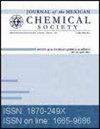生物质(杉木桉)作为吸附剂的利用-去除废水中的亚甲基蓝
IF 0.8
4区 化学
Q3 CHEMISTRY, MULTIDISCIPLINARY
引用次数: 0
摘要
摘要活性炭(AC)作为吸附剂对杉木生物量的影响的相关研究此前未见报道。最近的工作综合了一系列的研究,了解了吸附剂去除染料的各种实验参数,平衡时间和温度。物理结构表征表明,活性炭的表面积从399 m2增加到475 m2。G-1表明,原料生物质比活性炭表面更致密。在3406.29 cm-1 ~ 3414.0 cm-1之间的区域发现了导致氢键形成的(-OH)拉伸基团。研究了原料活性炭和活性炭对亚甲基蓝的吸附作用。活性炭的平均活化能为33.67 kJ。mol-1,略低于原料碳的49.14 kJ.mol-1。采用Elovich和Bhangam模型对20、30和40℃时的动力学研究进行了评价。由吸附动力学计算热力学参数ΔH≠、ΔS≠、ΔE≠。结果表明,吸附过程是自发的。熵的负值决定了酸分子在吸附剂表面的定向位置。结果表明,所有的模型都是最适合吸附的。Resumen。关于杉木桉(Eucalyptus lanceol杉木桉)的活化剂(CA)与生物活性因子(CA)的相关性研究尚无investigación相关报道。El reciente trabajo sintetizó una serie de studios para conconer diversos parámetros实验时间平衡与温度平衡与吸附para eliminación del colorante。La caracterización de La structura física determinó que el aumento del área superficial del carbón activado de 399 a 475 m2。G-1揭示了生物表面的奥秘tenía表面的奥秘más密实的奥秘carbón活性的奥秘。在此基础上,研究了红外光谱(FTIR)在中国的应用(región): 3406.29 cm-1 ~ 3414.0 cm-1;见estudió la adsorción de azul de metileno en carbón crudo y activado。energía de activación media del carbón activado fue de 33,67 kJ。mol-1, ligeramente a la del carbón bruto, que fue de 49,14 kJ.mol-1。本文采用difusión intrapartícula, Elovich和Bhangam的应用模型,对温度为20、30和40℃的高温进行了分析。Los parámetros termodinámicos, ΔH≠,ΔS≠y ΔE≠se calcularon a party de la cinsamtica de adsorción。Los resultados indican que la adsorción es un process espontáneo。El valor negative de la entropía determinó que las molcculas de ácido toman una posición orientada en la表面del吸附剂。Los resultados muestran que todos Los modelos se ajustaron major para adsorción。本文章由计算机程序翻译,如有差异,请以英文原文为准。
Utilization of Biomass (Eucalyptus Lanceolata) as an Adsorbent - Removal of Methylene Blue from Wastewater
Abstract. Investigation relevant to the influence of activated carbon (AC) supports biomass of Eucalyptus Lanceolata as an adsorbent was not reported previously. The recent work synthesized a series of studies to know various experimental parameters equilibration time and temperature of the adsorbent for the elimination of dye. Physical structure characterization measured that the surface area of activated carbon increased from 399 to 475 m2.g-1 revealed that the raw biomass had more compact surface than those of activated carbon. FTIR bands were found in the region between 3406.29 cm-1 and 3414.0 cm-1 indicates (-OH) stretching group which leads to hydrogen bonding. Adsorption of Methylene blue was studied on raw and activated carbon. The average activation energy of the activated carbon was 33.67 kJ.mol-1, slightly lower than those of raw carbon, which was 49.14 kJ.mol-1. Intraparticle diffusion, Elovich and Bhangam models were applied to evaluate kinetics studies at 20, 30 and 40 ºC. Thermodynamic parameters, ΔH≠, ΔS≠ and ΔE≠ were calculated from the adsorption of kinetics. Results indicate that adsorption is a spontaneous process. The negative value of entropy determined that the acid molecules take an oriented position on the surface of the adsorbent. The results show that all the models were best fitted for adsorption.
Resumen. Una investigación relevante y no reportada previamente respecto a la influencia del carbón activado (CA) apoya que la biomasa de Eucalyptus Lanceolata es un adsorbente. El reciente trabajo sintetizó una serie de estudios para conocer diversos parámetros experimentales de tiempo de equilibrio y temperatura del adsorbente para la eliminación del colorante. La caracterización de la estructura física determinó que el aumento del área superficial del carbón activado de 399 a 475 m2.g-1 revela que la biomasa cruda tenía una superficie más compacta que las del carbón activado. Se encontraron bandas FTIR en la región entre 3406.29 cm-1 y 3414.0 cm-1 indicando el estiramiento del grupo (-OH) que conduce al enlace de hidrógeno. Se estudió la adsorción de azul de metileno en carbón crudo y activado. La energía de activación media del carbón activado fue de 33,67 kJ.mol-1, ligeramente inferior a la del carbón bruto, que fue de 49,14 kJ.mol-1. Se aplicaron modelos de difusión intrapartícula, Elovich y Bhangam para evaluar estudios cinéticos a 20, 30 y 40 ºC. Los parámetros termodinámicos, ΔH≠, ΔS≠ y ΔE≠ se calcularon a partir de la cinética de adsorción. Los resultados indican que la adsorción es un proceso espontáneo. El valor negativo de la entropía determinó que las moléculas de ácido toman una posición orientada en la superficie del adsorbente. Los resultados muestran que todos los modelos se ajustaron mejor para la adsorción.
求助全文
通过发布文献求助,成功后即可免费获取论文全文。
去求助
来源期刊
CiteScore
2.00
自引率
0.00%
发文量
0
审稿时长
6-12 weeks
期刊介绍:
The Journal of the Mexican Chemical Society (J. Mex. Chem. Soc.) is a scientific, blind, peer reviewed, and open access, free of charge publication that covers all areas of chemistry and its sub-disciplines (i.e. medicinal chemistry, natural products, electrochemistry, material science, computational chemistry, organic chemistry, bionirganic chemistry, etc). It is devoted to facilitating the worldwide advancement of our understanding of chemistry. It will primarily publish original contributions of research in all branches of the theory and practice of chemistry in its broadest context as well as critical reviews in active areas of chemical research where the author has published significant contribution. The J. Mex. Chem. Soc. is a quarterly publication which language of submission and publication is English. To be suitable for publication in J. Mex. Chem. Soc., manuscripts must describe novel aspects of chemistry, high quality of results and discussion an excellent bibliographic support, and contribute to the development of the field. Routine or incremental work are not suitable for publication in J. Mex. Chem. Soc. Authors are encouraged to send contributions in electronic form. Our online submission system guides you stepwise through the process of entering your article details and uploading your files.

 求助内容:
求助内容: 应助结果提醒方式:
应助结果提醒方式:


